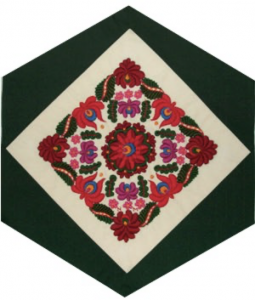Hungary

The Block
The richly coloured, stylized leaves and flowers in this block are typical of the traditional Hungarian embroidery called Matyó. This shiny, multi-coloured needlework is a relatively young type of folk art in Hungary, less than 150 years old, but is one of the most well-known in the country. The design is created on 100% cotton with cotton perle thread closely stitched by Monika Nemeth in the eight customary colours of red, yellow, blue, purple, pink, burgundy and two shades of green.
Cultural Profile
Hungary, a landlocked country located in central Europe, is best characterized by its rural nature. Although the country is influenced by a number of other languages, the official language is Hungarian, also called Magyar, which is distantly related to the Estonian and Finnish languages. The Magyars are the dominant ethnic group in Hungary with Roma (Gypsies), Germans and Slovaks the largest ethnic minorities.
Hungary’s capital, Budapest, is considered to be one of the most beautiful cities in Europe. Tourists flock to the city to see the beautiful architecture and enjoy the spas. The abundance of thermal sources in Budapest are the reason why the Romans founded the city. The tradition continues to this day, with locals regularly visiting the many spas found in and around the city or one of the ‘water discos’.
The desire to please and entertain, passed on from one generation to the next in music, dance, crafts and costumes, is at the heart of Hungarian culture. Hungarians are also known for their deep love of music and dancing (the lively national dance is the Csárdás). Hungarian composers such as Franz Listz, Zoltán Kodály, Karl Goldmark and Béla Bartók have also made a huge impact in the world of classical music. For many, the folk music was the inspiration for their classical compositions.
Hungarians also have a strong folk art tradition as seen in their colourful and elaborately embroidered costumes (kalocsai) and beribboned headdresses. The costumes of younger women are usually very colourful, while those for older women are black, blue or green featuring whitework embroidery. Another Hungarian form of embroidery is the Matyó, which flourishes in the western Hungary around the town of Mezőkövesd. Matyó embroidery adorns traditional costumes and household items, and its designs are often used featured on furniture and pottery. Halas lace is a style of lace that was created in Hungary in the early 20th century and is now known worldwide. Hungarians are also known for their decorative paintings, wood and bone carvings, leather goods, and pottery. Hungary is also the homeland of Ernό Rubik, inventor of the Rubik’s or Magic Cube, and Laszlo Bίró, inventor of the ballpoint pen.
In the 1880s, Hungarians arrived in Western and Central Canada primarily as farmers. However, the mass emigrations of 1948 and 1956 included as many as 100,000 people with a greater diversity of skills, training and occupations. There are over 316,000 people of Hungarian ancestry now living in Canada with strong communities in Montreal, Winnipeg, Edmonton and Vancouver. Actively involved in ethnic associations, Hungarians proudly maintain their language and culture, both at home and in the community, through various publications and bulletins, television and radio programs, cooking and the celebration of traditional events.
Sponsor: Mr. and Mrs. Bela A. Rieger and the Canadian Hungarian Folklore Association
